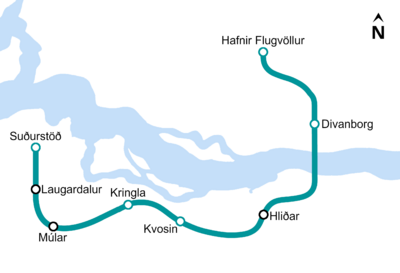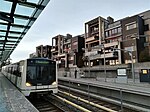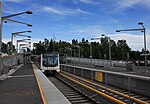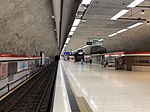Difference between revisions of "Hafnir Metro"
LeotropolisG (talk | contribs) |
LeotropolisG (talk | contribs) |
||
| Line 97: | Line 97: | ||
[[File:MX3000 interior.jpg|thumb|Interior of the N1000]] | [[File:MX3000 interior.jpg|thumb|Interior of the N1000]] | ||
| − | The current rolling stock consist of 5 metro trains known as N1000 and has permanent way equipment, ordered in 2006 to replace the old N500. Delivery started in the same year but only 3 were delivered out of 5. Till early 2007 The two vehicles operated together until the last 2 were changed as well. The Suðurstöð depot is the main storage and maintenance yard for all Hafnir Metro trains. | + | The current rolling stock consist of 5 metro trains known as N1000 and has permanent way equipment, ordered in 2006 to replace the old N500. Delivery started in the same year but only 3 were delivered out of 5. Till early 2007 The two vehicles operated together until the last 2 were changed as well. The Suðurstöð depot is the main storage and maintenance yard for all Hafnir Metro trains. The metro requires drivers to operate. |
[[File:I12 065 Hp Røa, ET 3198.jpg|thumb|N1000 on the rolling line]] | [[File:I12 065 Hp Røa, ET 3198.jpg|thumb|N1000 on the rolling line]] | ||
[[File:Typ U2 Ottakring.JPG|thumb|The older version, N500]] | [[File:Typ U2 Ottakring.JPG|thumb|The older version, N500]] | ||
Revision as of 02:21, 16 September 2022
| Hafnir metro | |||||||||||||||||||||||||||||||||||||||||||||||||||||||||||||||||||||
|---|---|---|---|---|---|---|---|---|---|---|---|---|---|---|---|---|---|---|---|---|---|---|---|---|---|---|---|---|---|---|---|---|---|---|---|---|---|---|---|---|---|---|---|---|---|---|---|---|---|---|---|---|---|---|---|---|---|---|---|---|---|---|---|---|---|---|---|---|---|
 | |||||||||||||||||||||||||||||||||||||||||||||||||||||||||||||||||||||
| Overview | |||||||||||||||||||||||||||||||||||||||||||||||||||||||||||||||||||||
| Native name | Neðanjarðarlestakerfi Hafnir | ||||||||||||||||||||||||||||||||||||||||||||||||||||||||||||||||||||
| Owner | City of Hafnir | ||||||||||||||||||||||||||||||||||||||||||||||||||||||||||||||||||||
| Locale | Hafnir | ||||||||||||||||||||||||||||||||||||||||||||||||||||||||||||||||||||
| Transit type | Rapid transit | ||||||||||||||||||||||||||||||||||||||||||||||||||||||||||||||||||||
| Number of lines | 1 in operation | ||||||||||||||||||||||||||||||||||||||||||||||||||||||||||||||||||||
| Number of stations | 8 | ||||||||||||||||||||||||||||||||||||||||||||||||||||||||||||||||||||
| Daily ridership | 73,500 | ||||||||||||||||||||||||||||||||||||||||||||||||||||||||||||||||||||
| Annual ridership | 26,827,500 | ||||||||||||||||||||||||||||||||||||||||||||||||||||||||||||||||||||
| Website | Neðanjarðarlestakerfi.rey | ||||||||||||||||||||||||||||||||||||||||||||||||||||||||||||||||||||
| Operation | |||||||||||||||||||||||||||||||||||||||||||||||||||||||||||||||||||||
| Began operation | 24 June 1992 | ||||||||||||||||||||||||||||||||||||||||||||||||||||||||||||||||||||
| Operator(s) | City of Hafnir | ||||||||||||||||||||||||||||||||||||||||||||||||||||||||||||||||||||
| Number of vehicles | 5 | ||||||||||||||||||||||||||||||||||||||||||||||||||||||||||||||||||||
| Train length | 3 car | ||||||||||||||||||||||||||||||||||||||||||||||||||||||||||||||||||||
| Technical | |||||||||||||||||||||||||||||||||||||||||||||||||||||||||||||||||||||
| System length | 7.8 km | ||||||||||||||||||||||||||||||||||||||||||||||||||||||||||||||||||||
| Track gauge | 1,435 mm (4 ft 8+1⁄2 in) | ||||||||||||||||||||||||||||||||||||||||||||||||||||||||||||||||||||
| Electrification | 750 V DC | ||||||||||||||||||||||||||||||||||||||||||||||||||||||||||||||||||||
| Average speed | 32.5 km/h | ||||||||||||||||||||||||||||||||||||||||||||||||||||||||||||||||||||
| Top speed | 80 km/h | ||||||||||||||||||||||||||||||||||||||||||||||||||||||||||||||||||||
| |||||||||||||||||||||||||||||||||||||||||||||||||||||||||||||||||||||
The Hafnir Metro (Reykani:Neðanjarðarlestakerfi Hafnir), (Salisfordian:Metropolitana di Hafnir) is the rapid transit system that operates in Hafnir, Reykanes and it is operated by the City of Hafnir. It started operation in 1994. The network consist of a single line that runs through the city centre, having the length of 9,8 km and a total of 8 stations of which 5 are underground. as of 2020 73,5000 passengers use the metro daily and 26,827,500 passengers rode the Hafnir metro per year.
History
Construction
At the time the city was effected by a massive population growth and due to the high demand of a new transit in the city center as opposed to buses a plan was made to solve the problem. During the 1980s, road congestion in the vicinity of Hafnir rose dramatically, resulting in the City Council becoming interested in the adoption of a new mass transit platform to provide an alterative means of access around the city. In the late 80s the transit company, Tej proposed to build a new light rail from one of their major train stations, the southern station. They started to build the first two stations from there, hence those stations are above ground today. However it quickly became unpopular as the light rail that was planned wasn't suited for a urban center. Following studies of several mass transit systems, it was decided that the development of a light metro would be the most suitable option. A metro that is specifically designed to run in metropolitan cities , It was quickly envisioned to build a rapid transit underground to fit the scene better. It was planned to build a long straight metro line on the southern part of the city, but they soon hit a important archaeological site dating back to the early history of Reykanes. In the end it was decided to change the direction of the metro towards the international airport, crossing the river underground.
Network
The Metro services run between 05:00 and around 22:00 at intervals between two and five minutes during the day and up to eight after 20:00. During late night events such as a football match the metro will operate longer till 01:00. The metro connects the biggest rail station and the only international airport in Reykanes and between the local bus hubs and two stadiums such as the Reykani national stadium.
there is plans for further extensions of the metro line or entirely a new line in the next decades but there is no sign from the government of them using the plans until the city is hit by a massive population increase.
Line(s)
Line 1
| Line 1: Suðurstöð-Hafnir flugvöllur | |
|---|---|
Rolling stock
The current rolling stock consist of 5 metro trains known as N1000 and has permanent way equipment, ordered in 2006 to replace the old N500. Delivery started in the same year but only 3 were delivered out of 5. Till early 2007 The two vehicles operated together until the last 2 were changed as well. The Suðurstöð depot is the main storage and maintenance yard for all Hafnir Metro trains. The metro requires drivers to operate.











